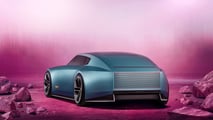
Jaguar’s title sponsorship of Miami Art Week featured its own blank canvas in the Type 00, a concept car the brand hopes will spawn some electric masterpieces beginning in 2026. Its design is remarkably striking, easily the most interesting thing Jaguar has done in years.
But design is one thing; making a business out of it is another, and Jaguar is running out of time.

The Miami venue underscored the brand’s intention to collaborate with artists, who aren’t known for buying roughly $120,000 EVs; but also to market to wealthy coastal types who might. Forget the gray U.K. or a gritty Detroit in January—that’s so 1960s. Forget British punters crying in their Guinness over classic E-Types. They’re ambivalent at best toward EVs, and probably can’t afford these cars anyway. JLR estimates only 10 to 15% of current customers will come along for the ride.
That brings us to the first of Jaguar’s problems and possibly the ninth of its lives: lately, Jaguar hasn’t had many customers at all. The brand sold 8,348 cars in America in 2023, down nearly 80 percent since 2017, and about 64,000 worldwide. Mercedes and BMW each sold about 40 times that many cars in the U.S. Its current lineup, if you can even call it that, is just holdovers from the previous decade like the once-groundbreaking but now irrelevant electric I-Pace.

As company executives note, that has proven the folly of butting heads with BMW, Benz or even Genesis in the mass-luxury ranks. Blame whatever you like, a dodgy quality reputation, anodyne designs, a revolving door of ownership and strategies. That includes balling and tossing a near-completed electric XJ design, and $634 million with it.
These are valid diagnoses of an ailing brand. But I prefer a swipe with Occam’s Razor: Jaguar is a sedan and sports-car specialist in a world that has turned its back on sedans and sports cars. And Range Rover has the SUV-heritage-thing wrapped up, leaving scraps for its starveling sister.
Jaguar’s good old days are over, and its internal-combustion ways weren’t working. So the brand will shutter its factories, pretend 2025 isn’t a thing, and start fresh in 2026. Type 00 might refer to the revenues Jaguar will generate between now and then.
More seriously, U.S. dealers, their count already reduced to 120, will spend at least 12 months unloading a staggered inventory of leftovers, including the excellent but oft-overlooked F-Pace SUV. You think you’re peeved about Jaguar’s reimagining? I’m sure those long-suffering franchisees love to hear Jaguar tout posh new in-house stores to offer “immersive steps into the world of the Jaguar brand.” This red-hot industry trend, whose failures include a now-shuttered Cadillac House in Manhattan, has shown little to no evidence of boosting sales or brand image.
But at its Gaydon design studios, where I saw the Type 00 prior to the Miami reveal, Jaguar showed a rendering of a future store design: More shelter-magazine fantasy than traditional dealership, complete with a dramatic spiral staircase. Jaguar plans to open the first of these brand showcases in Paris’ “Golden Triangle” luxury-fashion district in the 8th arrondissement.

The question lingers: How many Parisians, Persians or Philadelphians will spend six figures on an electric Jaguar? As Rawdon Glover, managing director, confirmed in an interview, the brand plans to boost average transaction prices from today’s $60,000 to roughly $120,000.
Considering today’s option-stuffed luxury models, that to me suggests base prices closer to $100,000, which I believe Jaguar had better be targeting through ruthlessly disciplined design, supplier deals, and resource sharing. Much higher than that, and the air gets thin and customers are finicky and scarce—especially for an underdog like Jaguar.
Plot an industry sales chart based on prices, and you’ll be struck by how new-car sales tumble off a cliff above $100,000. That surprisingly small niche of buyers tends to head straight to blue-chip ICE perennials, your Porsche 911s, Mercedes G-Classes and S-Classes, a few BMWs. Oh, and Range Rovers.

Normally, if people don’t want your $60,000 cars, shooting for $120,000 sounds like madness. But these aren’t normal times. Like many legacy brands, Jaguar rightly sees its current fossil-fueled path as a dead-end. If you’re going to go down, you might as well go down swinging, with three chances to hit a home run or even a bloop single. The strategy appears simultaneously desperate, smart and necessary. The entire industry, including mainstream GM and Ford, has figured out it’s better to build fewer cars and charge much more for them, rather than go broke chasing volume and market share.
So Jaguar will aim for just 50,000 global sales, a fraction of the roughly 130,000 it sold under Ford’s high-volume auspices in 2002. Glover believes Jaguar can make money at those volumes, and finally carry its weight within JLR.
If Jaguar has a trump card, it’s Gerry McGovern, and his status as likely the industry’s most successful contemporary luxury designer and turnaround artist. McGovern basically hit reset on Land Rover after its own years in the wilderness. When you see people routinely paying $200,000 and more for top Range Rovers; and their sleek convoys on shows like Succession that have become a stereotypical visual shorthand for wealth and power, you can thank McGovern. Now running the entire JLR design show from a tastefully curated office in Gaydon, McGovern won’t be getting his hands dirty with Jaguar clay models, but nothing will reach showrooms without his signoff. And considering McGovern’s track record, I’m not ready to bet against him.
For all that, Jaguar may still be leaping from frying pan to fire.

I can’t shake a suspicion that Jaguar is trying to locate an imaginary slice of the market where competition doesn’t exist, or will curl up in a ball when faced with Jaguar’s (purportedly) superior designs. When I asked Glover to name the brands or models Jaguar was benchmarking or viewed as rivals, he demurred; saying Jaguar had often spent too much time worrying about the competition and was better off playing its own confident game. Fair enough.
Yet at Gaydon, Glover and other execs took plenty of broad shots at today’s luxury EVs as being generic, cab-forward transportation pods, designed to satisfy wind tunnels rather than discerning eyes. (I’d say “Looking at you, Mercedes,” but I’m not telling them anything they don’t already know.)
In contrast, Jaguar’s distinctive, design-led models would stand out and carry the day. But even recently, Jaguar often boasted the sexiest cars in various segments—the XJ sedan, the F-Type sports car and F-Pace SUV—and a fat lot of good it did them. Jaguar needs to bring the performance, tech, quality, everything, and not just show up at the party with the sharpest suit and prettiest bouquet.
If Jaguar won’t breathe a few Voldemort names, I will: Porsche, Mercedes, BMW, Audi and Lucid to start. All of those brands, I humbly submit, have managed distinctive EV designs of their own. Then there’s Tesla, which will flip you a Model S Plaid for $89,900. The Tesla may not be as swanky as a future Jaguar, but it’s got 1,020 horsepower, will cost roughly $30,000 less.
And there are signs that the uber-wealthy would rather pay for the privilege of internal combustion.
Global sales of the Porsche Taycan, a benchmark luxury EV, have tumbled a whopping 50% in 2024, though the heavily updated 2025 models aren’t out in force yet. Mercedes’ EQS sedan, with base prices ranging from about $105,000 to $129,000, has failed to win over traditional Mercedes ICE customers or conquest new ones. Despite stellar performance and industry-leading range and efficiency, Lucid’s Air has not done what the Model S did for Tesla. If Porsche, Mercedes and Lucid are struggling in the EV stratosphere, what chance does Jaguar have?
Other nagging questions include the brand’s ability to make money with a standalone Jaguar Electric Architecture. Can Jaguar sell enough cars and share enough components with Range Rover to balance the books and justify that investment?
Jaguar is also failing to take a lesson from Lucid’s gravest mistake, which was coming to market with a sedan first and not a higher-volume SUV. Akin to Lucid, Jaguar says its sedan-shaped GT will establish a design language and underscore its electric bona fides. But Americans especially don’t care about high-minded philosophies; they just want SUVs.
To the good: Jaguar may be out of cars for now, but it’s not out of money, engineering and resources. And nearly every EV purveyor, legacy or start-up, is currently struggling to make a go of it. Lucid and Rivian have yet to earn a profit, and are burning through billions of dollars each quarter, with the Saudis and Amazon/Ford as their respective key financial patrons. At Ford, the F-Series is the real sugar daddy, that bankrolls and offsets an EV operation that’s losing billions.

Jaguar’s deep-pocketed patron is Tata Group, India’s mightiest conglomerate. JLR itself posted record revenues of $36.3 billion in the last fiscal year. JLR’s $2.75 billion in profit is its highest since 2015. Wait, actual profits? Lucid’s Peter Rawlinson and Rivian’s RJ Scaringe would pop champagne at the very thought. Sure, Land Rover generates roughly 100 percent of those earnings. But Land Rover has been carrying Jaguar like a sickly kitten since Ford sold both brands to Tata 16 years ago. What’s a few more?
Finally, the Jaguar name still carries more recognition than any start-up. Among laypeople, I hear this all the time: What’s a Rivian? Lucid, you say? But people know Jaguar, for better or worse. Their doctor or neighbor once drove one. A mechanic told them they should never buy one. In this brand-obsessed culture, that three-syllable name—redolent of classic cars, fragrant leather, British royals, the gentrified good life—still has potential value. If this revival fails, I can see the brand being sold to a Chinese automaker just as BMW bought Britain’s foundering Rover Group in 1994, then broke it up and sold the Land Rover portion to Ford in 2000.
Something else is being overlooked. Jaguar appears on track to become the world’s first legacy luxury brand with an all-electric lineup, even as others backpedal from promises. For people who support EVs and the fight against climate change, wasn’t that the idea all along? So let’s go easy on the hot-pink outrage, reserve judgment for now, and maybe hope that this once-glorious brand can thrive again.
Jaguar’s electric transformation does appear to be the ultimate Hail Mary play. But teams draw it up for a reason: Every once in a while, it works.
Gallery: Jaguar Type 00 Concept







Lawrence Ulrich is an award-winning freelance automotive journalist. He's also the former chief auto critic of The New York Times and a contributing editor at Road & Track.







